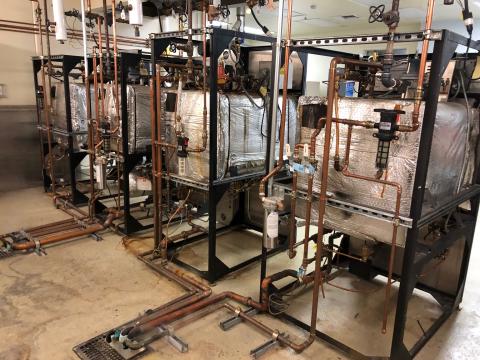Making Science More Sustainable

UC Santa Barbara is a world renowned research university and a pioneer in sustainability — two areas that don’t always go together. But thanks to the wonderful individuals in our Laboratory Resources, Advocates, and Teamwork for Sustainability (LabRATS) program, our university can lead the way in both.
LabRATS, lead by Katie Maynard and Amorette Getty and supported by two undergraduate interns, helps on-campus researchers reduce their impact on the environment while improving safety and maintaining good lab management practices. That means never sacrificing safety or research, but rather asking the question, “how can labs do what they need to do — be an environment for safe and uncompromised research — while also running in a resource efficient way?”. The answer to that question has led them to adapt campus recycling and energy management programs to the unusual materials used and processed in laboratories. But more recently, the group has shifted their attention to water conservancy.
The first task on LabRATS’ agenda was to replace soft plumbed single pass-cooling systems, a process that uses cold water to cool down extremely hot water to avoid pipe damage. The problem with this process was that the water was constantly being poured into the drain and wasn’t being reused. So LabRATS offered replacements for single pass cooling systems. At this point, all known soft plumbed single pass cooling systems on campus have been replaced. wrapping up that project doesn’t mean the LabRATS team gets to take a break. They’ve already started tackling another huge water efficiency project: autoclaves.
If you’ve never worked in a campus lab, you’re most likely wondering, what is an autoclave? An autoclave is a chamber that uses pressure and steam to sanitize lab materials, mostly glassware. In additional to the steam used for sanitation, water is also used to create a steam jacket that insulates the high temperature chamber, and in the vacuum process needed for drying the materials. Finally, most of this water gets poured out of the machine into the drain. Autoclaves are used to kill all bacteria and remove any contaminants from tools, making them vital for researchers.
However, on the sustainability side, autoclaves definitely have some room for improvement. UC Santa Barbara has 34 autoclaves in various campus research facilities, and many of them run 24/7 to ensure availability to researchers. 12 of these autoclaves already have water savings features installed. LabRATS worked with building managers, researchers, and departmental managers to understand which autoclaves could be retrofitted to include new water savings features. One of the most effective water savings features that can be installed is an eco saver unit. According to LabRATS leader Amorette Getty, these eco-savers “save more the more you use them,” so they are most practical on autoclaves that get used constantly. These units save some of the water that would have been sent down the drain for future cycles of the equipment. LabRATS will be adding eco-saver units to 6 autoclaves this fall through a grant from The Green Initiative Fund. The 6 eco-savers are estimated to save 3.4 million gallons of water per year.
Numbers aside, the work LabRATS has done to make their assessments and suggest alternatives has implications that extend beyond autoclave users. By digging deep into the frequency and use practices regarding these machines, they identified areas where departments excel and areas where they have room to improve, and these improvements can apply to all departments. Getty explains that “This is an integral problem that the department is dealing with that has the potential for cross-impact.”